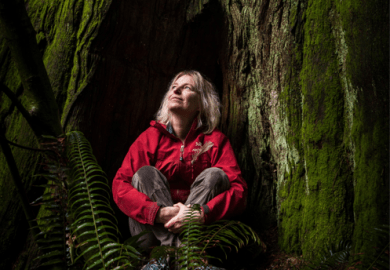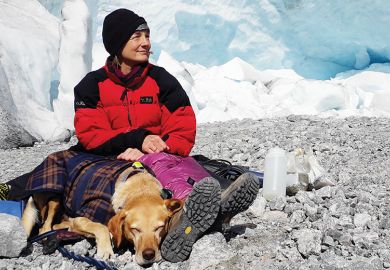The publication in 1989 of the book cleverly titled Wonderful Life by the Harvard professor and arch populariser of science-with-an-evolutionary-flavour, Stephen Jay Gould, quite literally catapulted the Cambridge-affiliated scientific crew of Harry Whittington, Derek Briggs and Simon Conway Morris into the public gaze as few other books have done. Until that moment these rather shy and retiring men had spent the two previous decades studying and publishing reports, written and illustrated often in mind-numbing detail, on the fossilised remains of creatures who had lived on the sea floor of an ancient ocean some 530 million years ago.
To an outsider this really does sound like the stuff with which the "groves of academe" are paved. But wait, these animals, collected from an outcrop of rocks known as the Burgess Shale, which is to be found only in the Rocky Mountains of British Columbia, Canada, were by no means ordinary fossils - not that any fossilised creature is all that ordinary. First, a quirk of fossilisation (still not completely understood) led to their being preserved in exquisite detail - such that even their soft parts often remain. In addition, the antiquity of these fossils is so great that they appear, by all accounts, to date back to a time thought to be close to that of the origin of all the more complex large animals with which we are familiar today.
So not only is the Burgess Shale a window of wonderfully preserved fossil animals - a so-called lagerstatte (deposit) - it also appears to provide a most conveniently opportune window on what might be a great and pivotal evolutionary event: the sudden appearance of the first really complicated and active forms of life. These are two rather obvious reasons why scientists might get not only interested, but really quite animated about the Burgess Shale.
Whittington, Briggs and Conway Morris have already been involved in the publication of books documenting the fossil treasures of the Burgess Shale, but not in the headline-grabbing way that Gould did in his book. This is partly a matter of style. Gould writes infectiously and well; he has a cleverly crafted journalistic turn of phrase and an enthusiasm that seems almost to bubble off the page and (curse him! - I am envious) has a way of making the natural sciences interesting to an impressively wide audience.
However, in Wonderful Life Gould wrote not only a biography of the study of the Burgess Shale and the efforts of the people involved, but also provided a vision, a broader overview - or, as he so often likes to put it, "a view of life", a phrase borrowed from the closing paragraph of Darwin's Origin of Species - about the pattern and mode of the history of life. In short, Gould's view, prompted in part by the work and some of the conclusions reached by the Cambridge scientists, was that our history and that of life on earth was one that could be traced back through the most slender and unpredictable of threads. Among the Burgess Shale fossils are the rare remains of a small (four to five centimetres long) eel-like creature (Pikaia) that appears to bear some of the hallmarks of the vertebrate group to which we, as humans, also belong. Gould "saw" that the animals of the Burgess Shale were not only remarkably well preserved, but were also a perplexing mix of familiar and alien forms. He deduced from this apparently amazing tapestry of disparate forms that only a small subset survives today: that many of the forms, alien to our eyes, had become extinct. He went on to suggest that those which had survived were not necessarily natural survivors. He saw them rather as lottery winners: creatures that had survived occasional (and in themselves unpredictable) periods of extinction largely by chance, rather than good genes as Darwin would have preferred. This was Gould's contingent view of the history of life. Life as we know it today was thus seen to be largely a consequence of a series of lucky breaks, rolls of the die, or whatever metaphor you care to choose.
We humans are, in his view, the product of an incredible series of lucky breaks, rather than the inevitable product of the shaping of genetic potential through Darwin's filter of natural selection.There are of course no answers to Gould's questions, but this is heady stuff when presented in his inimitable style and appealing to a fairly clear moral and political mindset if one wants to take it that way. While the power and clarity of exposition could not really be faulted in the late 1980s, it was possible to be a little pernickety over the matter of the science that lay beneath the purple prose: how much did Gould really know of the Burgess Shale and the nitty gritty of its fauna? Was he writing a book using this material to further his own agenda - his view of life?
It is a curious fact that until now none of the Cambridge protagonists has ever really expressed strong views about the evolutionary status or importance of the Burgess Shale despite their long association with the material. Perhaps Gould simply got in there first (an opportunistic strategy is in keeping with his philosophy) before the bulk of descriptive work had been completed. Or perhaps he represents an important, provocative ingredient that will spark the higher level interpretative work. Whatever the interpretation, it is certain that The Crucible of Creation would not have been written without Gould. In this book we have a resounding raspberry to the Gouldian foghorn of contingency.
The Crucible of Creation is an interesting and in some ways an odd book. It opens with a preface which contains the confession that Gould has indeed been the stimulus for this book, even if it simply serves as target practice for what Conway Morris might regard as his heavy artillery. We then move straight on to a glossary! I am not at all sure why it should appear before Chapter 1 without explanation, rather than at the end of the book as is normal; but I suppose it does immediately alert the non-expert reader to the existence of a glossary of terms, and warn a little of what is to come - a text that is in places pretty uncompromisingly scholarly, in other places pleasant and witty, and in others dense and verging on the pompous. Each chapter, in keeping with its scholastic bent, is liberally scattered with numbers that refer to the notes section following each chapter, wherein the reader can obtain further condensed information on particular points or references to scientific articles or books relevant to the topics. As Conway Morris states, these are by no means exhaustive in their treatment, but they would be exhausting for the general reader to pursue without access to a pretty reasonable scientific library. So who is the reader? To be honest, I am not sure. I suppose it is the ubiquitous "educated adult" and perhaps this is the market that Stephen Hawking tapped in to so remarkably and perplexingly.
Chapters 1 (The imprint of evolution), 2 (Setting the scene) and 3 (The discovery of the Burgess Shale) introduce the book in uncompromising fashion. The first chapter is easily the most striking and strident in its overview of the way in which biologists and philosophers have dealt with the history of life. The diversity of life today and its history revealed by the fossil record provide the canvas on which a number of scientist/philosophers have grappled with this issue. Among recent workers Richard Dawkins's view is pretty much dismissed as too narrow and unworldly in its focus on evolution through Darwinian mechanisms at a purely genetic level.
Contrasted with this is Gould, the real target. His views (agreeing with Darwin, but suggesting that there are additional mechanisms that also operate to regulate, control or modify evolution) are seen as not only flawed, but portrayed as rather sinister; parallels are drawn with the use of "resonant phrases" not only by Gould, but by extreme political propagandists of both the right and left. In fact you get the impression that Conway Morris regards Gould as a bit of a charlatan - trumpeting new ideas, creating a furore, ducking and weaving, moving on and then starting again from some other tack - the latest and most lamentable being his promotion of contingency in life (both past and by implication present).
The reply to Gould's claim of chance as a major factor in the history of life is found in Conway Morris's advocacy of evolutionary convergence. The fact of evolutionary convergence is well known, there are many examples: the placental wolf (Canis lupus) and marsupial wolf (Thylacinus cynocephalus) are incredibly similar despite the fact that we humans are more closely related to the placental wolf than is the marsupial form; fossil ichthyosaurs are remarkably similar to modern dolphins. Conway Morris does not see the evolution of life as a chancy event in the same way as Gould at all. He acknowledges contingency as an everyday matter, but not a significant shaping force. He sees life as rising in complexity over time and constrained by the general application of Darwinian principles of genetic variation and selection, but that life is also constrained by morphospace (the realm of possible body shapes and sizes).
Life is seen as not infinitely variable but as clustered in discrete areas of morphospace. Given that limitation, which he supports with some evidence from the fossil record (and through the ubiquity of convergence), it would in his mind lead inevitably to sentient humans or human-like forms over time. We are therefore seen as an inevitable product of the rise and diversification of life on this planet. This view is a philosophical and spiritual counterpoint to that of Gould and is underpinned by a rich sense of human moral responsibility and a strong spirituality that emerges at times in the book.
Having laid out his stall (so to speak), Conway Morris in the following two chapters provides a brief historical backdrop to the Burgess Shale, by considering the enigmatic fossils that are found in rocks older than it, and some of the interpretations of them, and then introduces the shale itself by outlining some of its history and the work of the interpreters. He goes on to look at what he calls "two mistakes". These are the now famous interpretations of Hallucigenia and Anomalocaris and the new work done on these animals. Whereas at the time of Wonderful Life these animals were regarded as weird and unlike anything ever seen before or since, they are now thought to resemble known living creatures to a surprising degree. In fact this work is beginning to make the Burgess Shale look more like an interesting array of primitive forms of life, rather than a shopping basket of freaks as Gould would have had us believe.
The fourth chapter is an interesting overview of the Burgess Shale using the notion of time travel to collect samples of living Burgess Shale animals and describe their appearance and probable behaviour. This is delightful, albeit speculative, and gives us an insight into Conway Morris's view of the biology of the animals he and others have studied for so long - this is in part at least the real "stuff" of paleobiology - attempting to resurrect these puzzling, squashed and fragmentary remains. Chapter five extends the work on the Canadian Burgess Shale by looking at recently described but similarly aged deposits from elsewhere in the world and the contribution that these are now making to enriching our understanding of early life.
Chapters 6-9 return to the larger questions relating to the meaning and importance of the Burgess Shale and larger issues about the history of life. Once again Gould is tackled head on, but from the point of view of one who knows the Burgess Shale and related faunas particularly well. The nature of the rise in diversity during Burgess Shale times is discussed, as is the diversification of body plans, and how we use anatomy to try to construct models which may (or may not) reflect the phylogeny of life.
We also get insights into some of the author's more specialised work on the early evolution of some of the major phyla (annelids, molluscs and brachiopods) via some extremely puzzling cataphract organisms (like chain-mail armoured slugs), such as the halkieriids from Greenland. Yet again the theme is ultimately one of unity of life, a drawing together of threads, a debunking of notions of "bewildering varieties" or "disparity".
In the end that is the strength of this book: it is less bleak in its assessment of life on earth and it is spiritually uplifting, rather than dry and mechanistic as some would have us believe. Conway Morris ends by speculating on a rather unfashionable notion: perhaps we are alone. Perhaps the evolution of life on any planet is a phenomenally rare event - no matter what the statisticians tell us about the vastness of the universe and the probability of other intelligent life, none has contacted us to date. If life is incredibly rare, then it is also precious, as is the earth and the life it supports; and therefore our responsibility as its custodians is awesome.
David Norman is director, Sedgwick Museum of Geology, University of Cambridge.
The Crucible of Creation: The Burgess Shale and the Rise of Animals
Author - Simon Conway Morris
ISBN - 0 19 850256 7
Publisher - Oxford University Press
Price - £18.99
Pages - 231
Register to continue
Why register?
- Registration is free and only takes a moment
- Once registered, you can read 3 articles a month
- Sign up for our newsletter
Subscribe
Or subscribe for unlimited access to:
- Unlimited access to news, views, insights & reviews
- Digital editions
- Digital access to THE’s university and college rankings analysis
Already registered or a current subscriber?



